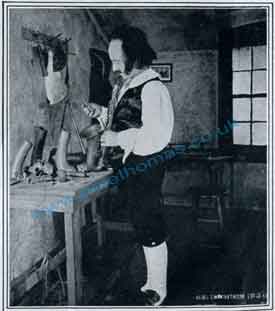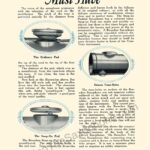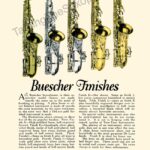
The Early Years of Saxophone History
Here we will look at some slightly different versions of saxophone history. The extracts from the Buescher catalogue do seem to pump up Mr Buescher’s role in the development of the saxophone!
From the Story of the Saxophone
The Middle Ages gave us a variety of new instruments and gradually the elements of the modern military band eveolved. All the French kings from Louis XIII on encouraged the development of these bands, and by the Revolution they were flourishing throughout the Empire.
It was not until 1814 that new instrument creations began to appear again, and it was in that same year, on November 6th, that a child was born in Dinant-Sur-Meuse, Belgium, whose name was destined to be heard around the world.
Even in his youth Antoine (later to be known as Adolphe) Joseph Sax became well known by his wonderful creations. He displayed great musical ability, and his father, Joseph Sax, who was a celebrated wind instrument maker, took great pains to encourage both his musical and his inventive genius.
Young Antoine was entered at the Brussels Conservatoire de Musique, where he studied Clarinet and Flute. The celebrated master, Bender, made of young Sax a clarinet player of great skill, but this skill was never applied professionally. Antoine’s natural bent was mechanical, so he returned to his father’s workshop, where he applied himself to the task of improving the clarinet.
Story of the Saxophone
Now available, this beautiful A4 reproduction of Buescher catalogue and saxophone book
See/download scanned extracts at the bottom of this page.
In 1842 he moved to Paris, where he opened a modest workshop on rue St. George. He became actively interested in Opera and created the opera band, for which he designed and made many special instruments. His superiority over all other instruments makers in Paris was so marked that Sax soon had to enlarge his quarters so as to handle the many orders for his instruments.
Then in 1846 Sax invented the instrument which bears his name. The rest, as they say, is saxophone history. He made a quartet of instruments, the soprano, alto, tenor and baritone, adding four new voices to the world of music. This was the crowning event in the life of the inventor, though Sax did not realise the importance of his accomplishment.
In 1859 there was a change in Concert Pitch, making it necessary for every military band and orchestra in France to procure new wind instruments. This was Sax’s opportunity. For through his friends at court he had secured a practical monopoly for the supply of wind instruments of his manufacture to the French army.
But as is often the way of all great men of genius, Sax continued in creative pursuits rather than turn to fortune hunting. He exhibited his instruments in London in 1862 and took the Grand Prize in Paris in 1867. His fortune continued to decrease until finally his factory in Paris passed into other hands. His magnificent collection of musical instruments was sold under the hammer.
There was a time in the career of Sax when he could have retired with a fortune. He had friends in high places and the assistance of prominent musicians such as Berlioz, Halevy and Kastner. He had won the favourable comments of the French press and applause of all Europe.
All this gave him a position rarely reached by men in middle life, but there came such a sharp turn. The grass grew green over his grave in the summer of 1894, a good quarter of a century before people hailed his invention as the worldwide success it later became. We have to wonder what would Adolphe would have made of the saxophone’s lead role in bringing about a musical revolution: jazz.
Saxophone History: the Twentieth Century

By the end of the nineteenth century, in spite of all the setbacks, the saxophone had become accepted, at least in military band circles. The advent of the jazz age did not however do much for the saxophone at first, the staple horn section of early jazz bands being clarinet, trumpet/cornet and trombone.
However it gained popularity among the public due to its acceptance into mainstream popular entertainment in the music halls and vaudeville shows. Rudy Wiedoft is a prime example of a virtuoso saxophonist who took it to extremes of expressivity and dexterity.
In the twenties, companies such as Conn and Buescher marketed it as a family instrument for which it was ideal. It wasn’t as raucous as trumpet or trombone and a folks could pick out a tune on it a bit more easily.
Most importantly the concert pitch version, the C melody, was readily available as a non-transposing instrument – perfect for the family as an accompaniment to Aunt Maude on the piano or to tote down to the church band and play along with some hymns.
But very soon a big development in saxophone history took place. It wasn’t long before it gained popularity in the new wave of jazz dance bands of the 30s where a section of saxophones were perfect for swing riffs or lush harmonies. It was soon to supercede the old front line of trumpet, clarinet and trombone as the most universal symbol of jazz.
The following is another extract from Buescher’s early marketing publication, “The Story of the Saxophone” (1926)
How F.A.Buescher Perfected the Belgian’s Idea
ALTHOUGH invented and first introduced over eighty years ago, saxophone history remained practically dormant for half a century.
It was then that Ferdinand A. Buescher, a young, aspiring mechanic, working away at his obscure bench in Elkhart, Indiana, made with his own hands and with many improvements the first saxophone, perhaps, ever produced in this country.
The Belgian had seen only a new type of musical instrument, while the new genius saw the world gay in rapture of a new style of music, singing, dancing, swaying, prancing to the tune of his perfected saxophone. And along with his vision he had what the Belgian lacked – keen business judgment and the courage to succeed.
Just as the violin made little impression on the music until Stradivarius had perfected it, so with the saxophone
The crude models of Sax offered little temptation or incentive to the musically inclined. They were most faulty in tone quality, not very accurately tuned, extremely hard to blow, cumbersome in key system, and generally unsatisfactory from technical and artistic standpoints.
In common with the instrument makers of his day, Sax left much to the performer, expecting him, by varying lip and wind pressure and skilful manipulation of the reed, to rectify the inherent defects of his saxophones.
F.A.Buescher first took up the models of Sax in much the way that a man following any artistic calling will take up the work of old masters – reverently, and with little thought of possible improvement. But as he got into the work he discovered many scale inaccuracies that he could remedy; many tapers that he could alter to improve tone-quality.
He made various improvements in the key system, springing, etc., and with his vast knowledge of the wind instrument making art, his skill at manipulating proportions, bores etc., he soon brought out a quartet of saxophones so far superior to the original invention that there was really no room for comparison.
Eventually the original four Sax models were expanded to the present nine Buescher models. They simplified the key system and put on the single-acting double octave key. Last, but by no means least, Buescher perfected and patented the Snap-On-Pad.
Mr. Buescher’s improvement contributions to the saxophone have been continuous and of increasing importance over a period of forty years. Today the Buescher Band Instrument Company produces the highest grade of saxophones and brass band and orchestral instruments in the world.
Every product of his mammoth plant is a testimony and a tribute to the skill of F.A. Buescher, the master craftsman, whose ingenuity and foresight and perseverance have made possible the international popularity of the saxophone and whose contribution to the world of music has brought fame and fortune to so many hundreds of people. Imitations! There are many! But the Buescher True-Tone remains without compare.
Story of the Saxophone Book
The actual book is a beautiful reproduction of the original Buescher 1926 catalogue. 32 page A4 book with high quality heavy semi-gloss pages. A great book for all lovers of the saxophone. You can preview or download a few of the pages here. The actual book is much higher resolution, you’ll love it!






